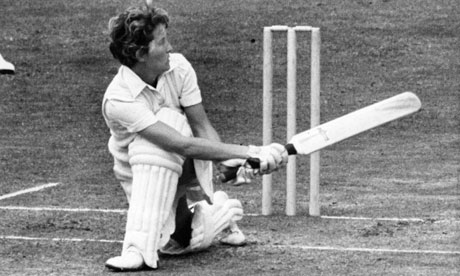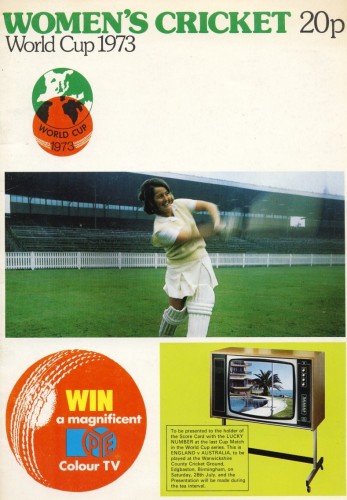PHILIP BARKER on how Rachael Heyhoe Flint and her England women’s team became cricket trail-blazers 40 years ago
Had it not been for the Syria vote in Parliament last week, women’s cricket would have been front page news after England regained the Ashes.

Extensive coverage on Sky television and BBC radio helped the series attract more attention than ever before, a vindication of the decision to include all three formats of the game in the Ashes.
The crowds for the Test match at Wormsley and the other matches have delighted England cricket supremo Clare Connor. “We’ve been overwhelmed by the media coverage. It has captured everybody’s imagination,” she said.
The England team’s success installs them alongside Alastair Cook’s men’s side as contenders for the Team of the Year award at our SJA Sports Awards in December. The SJA recognised the England women’s cricket team when our members gave them that award in 2009.
Forty years ago, though, it was the women who were the pacesetters . Their World Cup was established two years before the men’s. In 1973, the landscape for women’s sport was much less hospitable. Bobby Riggs had just beaten Margaret Court. Billy Jean King (who was eventually to beat Riggs) would look up at the Wimbledon scoreboard only to see Mrs LW King – her husband’s initials.
Sportsworld, Britain’s answer to Sports Illustrated, promoted the FA Cup Final with a cover depicting a topless model and some strategically placed rosettes. It was, they said, “ simply a bit of springtime sporting fun”.
And Cricket 73, the official glossy magazine from the Test and County Cricket Board, made no mention of the women’s World Cup. It was left to the England captain Rachael Heyhoe Flint who doubled as officer for press and sponsorship to spread the word.
The first match, scheduled for Kew Green Cricket Club on June 20 was a washout, but the weather improved and England beat an International XI by 135 runs in their opening match.
The tournament lasted a month. As well as the “International XI”, the teams included a Young England, Jamiaca and Trindiad and Tobago (rather than the West Indies). Games were played at places as varied as Ilford, Liverpool and Kirby Muxloe. Women were not yet welcome to play Lord’s, though they did get to practice in the nets. The final, 21st match of a league format competition was played, therefore, at Edgbaston. Someone had somehow ensured that the fixtures were well arranged, as it pitched together the two strongest teams, England and Australia. The match-winner would top the table and win the tournament.
There was no live television coverage. BBC cameras that day were at The Oval for the Saturday of the England v West Indies Test match.

Decades later, while filming a piece about the first MCC women’s XI, I went in search of footage of the final. A call to the ertstwhile England captain paid dividends.
Rachael disappeared to her attic and came up with a roll of home cine film, possibly the only moving footage of the match in existence. The pictures flickered into life to show England en route to 279 for 3 to set up a 92-run win and Princess Anne presenting the trophy at, it must be said, an Edgbaston less-than-brimming with spectators.
There had been coverage of the tournament in the broadsheets, but tabloid copy was hard to find. Jeff Farmer, later an ITV Sport executive, was filing for the Daily Mail.
PLENTY OF FINE LEGS BUT THIRD MEN HARD TO FIND ran the headline.
“The first thing to accept about women’s cricket is that they would not even argue with Bobby Riggs that they could beat the men,” he wrote . Farmer did make one basic point. “A cricket ball, even the ladies’ 5oz variety, is hard and this is where our women make the men look like a bunch of softies. Whilst Geoffrey Boycott takes strike at The Oval with a thigh pad thick enough to accommodate several years of Wisden, the ladies at Birmingham got by with a short skirt and a sun tan.”
Later that summer, cricket did indeed have its own “battle of the sexes” at The Oval. The match was devised by Mike Brearley and the SJA’s own Tom Clarke and supported by the Evening Standard. “I fear we shall suffer the same fate as Margaret Court unless we think up some suitable handicap for the men, such as drinking a pint every 10 runs they score,” Heyhoe Flint suggested in The Cricketer.
The men’s side hit the winning runs off the penultimate ball of the day
The men’s team included Tony Pawson of The Observer, who wrote about England’s World Cup success: “The only regret was that their win had not been as well acclaimed as their skill and initiative deserved.”
Across town at Lord’s, Ray Illingworth’s England Test side was en route to defeat to the West Indies by the small matter of an innings and 226 runs. It proved to be Illy’s last game in charge of the Test team. Heyhoe Flint lasted much longer, and she got to lead the team out for a one-day international against Australia at headquarters in 1976
That at least was shown on BBC’s Grandstand, albeit two days later, but it was another 23 years before women would be allowed in as members; next year an MCC women’s team will help commemorate the 200 years since Thomas Lord established his ground on its present site at St John’s Wood.
UPCOMING SJA EVENTS
Thu Dec 12: SJA 2013 British Sports Awards. Venue and ticket booking details to be announced soon
This is a list of current first-class cricket woman’s teams, Women’s (Women’s Test cricket,One Day International cricket (ODI,Women’s Twenty20 cricket,) is the limited overs form of women’s cricket.
http://www.worldcupslive.com/cricket/women-cricket/